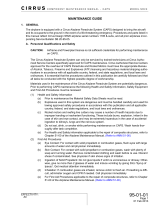Page is loading ...

DBS:_________________ SLIDER:_______________ OTHER:_______________
Asylum Designs' mission is to provide the highest quality BASE Jumping Equipment, BASE Training, and Customer
Service to jumpers world-wide. Our focus is on equipment innovation, safety, and support.
The Seven-- the finest canopy made specifically for BASE jumping. Initial careful assembly and subsequent inspections are
mandatory for safe and proper use.
Inspection/assembly:
Remove from bag and perform inspection of wing, including all attachment points, bar-tacks, bridle attachment, tail pocket,
surfaces- upper and lower- Connect your links to the risers. Be careful to not damage your risers as you assemble. The links
should be finger tight and then no more that a ¼ turn. The idea is so you can not loosen barrel without assistance or using a
tool. The silicone link covers have been provided for protection of the link and the slider grommets. Link covers serve the
purpose of maintaining alignment of the link (no side loading), and minimizing barrel slip. Check continuity of the canopy.
Although your new Seven has received thorough inspections both during and after production, it is important that you
perform a pre-jump inspection with any new or unfamiliar canopy. Asylum Designs recommends that your new canopy first
jumps be made from an aircraft. Canopy times deployed from an aircraft allows for plenty of time to asses and verify flight
characteristics and DBS prior to making a single parachute jump.
Before you BASE jump: If you intend to jump slider down, either remove the slider or secure it to the front connector links.
Use the line release modification. For slider up jumps, correctly install the slider and check continuity.
Attach the bridle to the bridle attachment. If you have a pin rig, the pins will be closest to the canopy. If using a velcro rig,
then the shrivel flap will attach to the bridle attachment, and then the no pin brilde will attach to the shrivel flap.
Brake settings/ Deep brake settings: Compared to skydiving, packing a BASE parachute in deeper brakes is preferred when
configured for slider removed or slider down jumps. This will make the pressurization and wing formation much cleaner and
minimize opening surge. The reduced length in control system will also lessen the possibility of a line over malfunction. With
a deep brake setting, the wing will be closer to a stall, and will react much differently compared to using the shallow setting,
normally used for slider up jumps.
Each Seven canopy arrives with a shallow (also called “factory”) setting and two deeper brake settings. The deepest setting is
set if you are on the heavy side of the wing loading, and the “medium” setting is if you are on the light side of the
recommended WL range. (.7-.75 lbs/sq ft is the ideal range) Each jumper has his own ideal DBS, dependent on jumper
weight, canopy size, opening altitude and canopy reefing (slider up or down). The two deeper settings on your new Seven
should be used for slider down jumping and the shallower one for slider up jumping.
Packing: The Seven is designed to pressurize and form quickly. This is ideal for slider-down (removed) jumping. A
balanced, symmetrical, tensioned pack job with exposed nose and tail control is recommended. For slider-up jumps, proper
PC selection, body position, along with nose exposure will determine the deployment speed. You will find that rolling the
nose will decrease the rate of initial inflow, and thus, slowing the inflation. You will discover a combination that works best as
a jumper in relation to the type of deployment requirements (WS, tracking, terminal, or sub-terminal).
Asylum Designs recommends you verify your ideal DBS before attempting to BASE jump your Seven. If the settings are
not in your range of operation, then arrange for a local rigger or us to make the adjustment. If you have any questions
please do not hesitate to contact us to discuss.
Parachute systems when properly assembled, packed and operated are still dangerous and unreliable. Be informed and
aware of all possibilities prior to use. The manufacturer makes no warranties expressed or implied for any actual or
consequential damages.
Seven
200
220
240
260
280
300
Serial #
D.O.M.

BASE jumping is dangerous. The consequences of your actions may be serious injury and/or DEATH. Proper training and
support are required to minimize the risks. Each individual must accept full responsibility for their decision to participate .
Seek answers, demand excellence, stay alive!
As y lu m Des ig n s
PO Box 5584, Auburn, CA 95604-5584
Email: support@asylumbase.com Home Page: www.asylumbase.com
Recommended Weight limits ( jumper + gear ) and deployment speed.
Model size
Maximum Weight
Maximum deployment
speed ( with Reefing)
Maximum deployment
speed ( without Reefing)
Seven 200
175 / 79kgs
130kts
70 kts
Seven 220
195lbs / 89kgs
130kts
70 kts
Seven 240
215lbs / 98kgs
130kts
70 kts
Seven 260
235 lbs/ 107kgs
130kts
70 kts
Seven 280
254lbs / 115kgs
130kts
70 kts
Seven 300
254lbs / 115 kgs
130kts
70 kts
/




